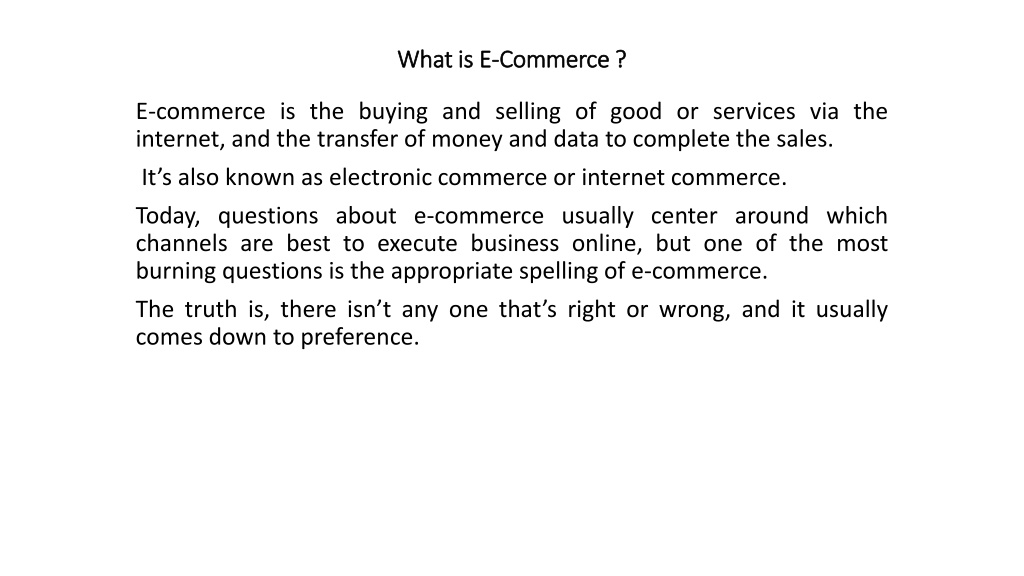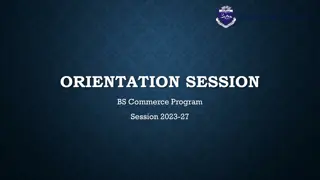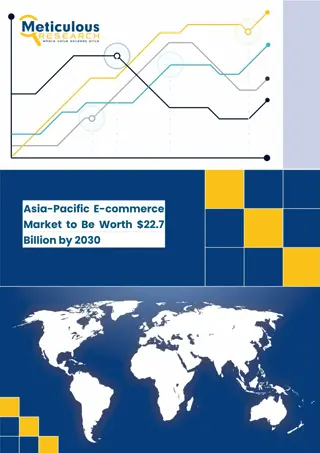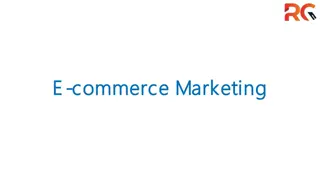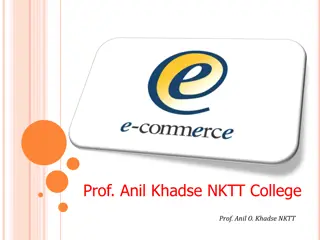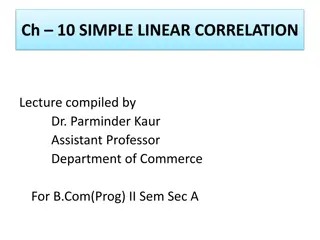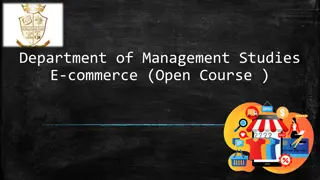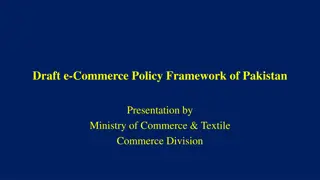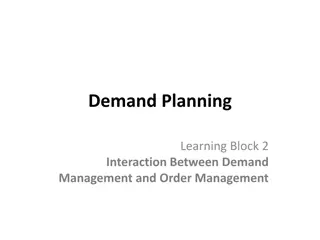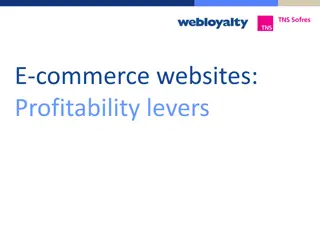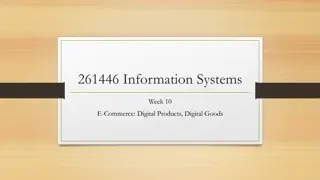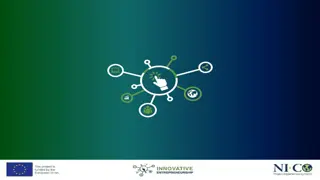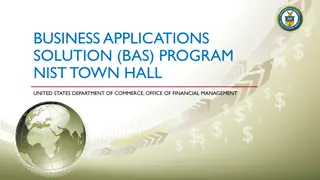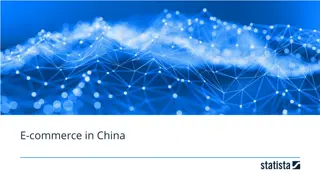Understanding E-Commerce: Evolution, Types, and Applications
E-commerce, or electronic commerce, involves buying and selling goods or services online. Explore the history, types (B2B, B2C, C2C, C2B), applications, and platforms in the dynamic world of e-commerce. Discover the impact of technology on online business interactions and consumer behavior.
Download Presentation

Please find below an Image/Link to download the presentation.
The content on the website is provided AS IS for your information and personal use only. It may not be sold, licensed, or shared on other websites without obtaining consent from the author. Download presentation by click this link. If you encounter any issues during the download, it is possible that the publisher has removed the file from their server.
E N D
Presentation Transcript
What is E What is E- -Commerce ? Commerce ? E-commerce is the buying and selling of good or services via the internet, and the transfer of money and data to complete the sales. It s also known as electronic commerce or internet commerce. Today, questions about e-commerce usually center around which channels are best to execute business online, but one of the most burning questions is the appropriate spelling of e-commerce. The truth is, there isn t any one that s right or wrong, and it usually comes down to preference.
History of E-Commerce The beginnings of e-commerce can be traced to the 1960s, when businesses started using EDI to share business documents with other companies. In 1979, the American National Standards Institute developed ASC X12 as a universal standard for businesses to share documents through electronic networks. After the number of individual users sharing electronic documents with each other grew in the 1980s, the rise of eBay and Amazon in the 1990s revolutionized the e-commerce industry. Consumers can now purchase endless amounts of items online, from e-tailers, typical brick-and-mortar capabilities. stores with e-commerce
Types of E-Commerce Business-to-business (B2B) e-commerce refers to the electronic exchange of products, services or information between businesses rather than between businesses and consumers. Business-to-consumer (B2C) is the retail part of e-commerce on the internet. It is when businesses sell products, services or information directly to consumers. Consumer-to-consumer (C2C) is a type of e-commerce in which consumers trade products, services and information with each other online. Consumer-to-business (C2B) is a type of e-commerce in which consumers make their products and services available online for companies to bid on and purchase.
E E- -commerce applications commerce applications E-commerce is conducted using a variety of applications, such as Email, online catalogs and shopping carts, Electronic Data Interchange (EDI), the file transfer protocol, web services and mobile devices. This includes B2B activities and outreach, such as using email for unsolicited ads, usually viewed as spam, to consumers and other business prospects, as well as sending out e-newsletters to subscribers and SMS texts to mobile devices. The rise of e-commerce has forced IT personnel to move beyond infrastructure design and maintenance to consider numerous customer-facing aspects, such as consumer data privacy and security.
E E- -commerce platforms and vendors commerce platforms and vendors An e-commerce platform is a tool that is used to manage an e- commerce business. E-commerce platform options exist for clients ranging in size from small businesses to large enterprises. A few examples of e-commerce marketplace platforms include: 1-Amazon 2- eBay 3-Walmart Marketplace 4- Alibaba
Advantages of e Advantages of e- -commerce commerce Benefits of e-commerce include its around-the-clock availability, the speed of access, the wide availability of goods and services for the consumer, easy accessibility and international reach. Availability. Aside from outages or scheduled maintenance, e-commerce sites are available 24x7, allowing visitors to browse and shop at any time. Speed of access. While shoppers in a physical store can be slowed by crowds, e-commerce sites run quickly, which is determined by compute and bandwidth considerations on both consumer device and e-commerce site. Wide availability. Amazon's first slogan was "Earth's Biggest Bookstore." They could make this claim because they were an e-commerce site and not a physical store that had to stock each book on its shelves.
Cont.. International reach. Brick-and-mortar businesses sell to customers who physically visit their stores. Lower cost. pure play e-commerce businesses avoid the cost associated with physical stores, such as rent, inventory and cashiers, although they may incur shipping and warehouse costs. Personalization and product recommendations. E-commerce sites can track visitors' browse, search and purchase history. They can use this data to present useful recommendations, and obtain valuable insights about target markets. and personalized product
Disadvantages of e Disadvantages of e- -commerce The perceived disadvantages of e-commerce include sometimes limited customer service, consumers not being able to see or touch a product prior to purchase and the wait time for product shipping. Limited customer service. If a customer has a question or issue in a physical store, he or she can see a clerk, cashier or store manager for help. In an e-commerce store, customer service may be limited. Not being able to touch or see. While images on a webpage can provide a good sense about a product, it's different from experiencing it "directly," such as playing music on speakers, assessing the picture quality of a television or trying on a shirt or dress. E-commerce can lead consumers to receive products expectations, which leads to returns. commerce that differ from their
Cont.. Wait time. If a customer sees an item that he or she likes in a store, the customer pays for it and then goes home with it. With e- commerce, there is a wait time for the product to be shipped to the customer's address. Although shipping windows are decreasing as next day delivery is now quite common, it's not instantaneous. Security. Skilled hackers can create authentic-looking websites that claim to sell well-known products. Instead, the site sends customers forfeit or imitation versions of those products -- or, simply collects customers' credit card information. Legitimate e-commerce sites also carry risk, especially when customers store their credit card information with the retailer to make future purchases easier. If the retailer's site is hacked, hackers may come into the possession of customers' credit card information.
Electronic Commerce and Trade Cycle Electronic Commerce and Trade Cycle A trade cycle is the series of exchanges, between a customer and supplier that take place when a commercial exchange is executed. A general trade cycle consists of following stages: Pre-Sales: Finding a supplier and agreeing the terms. Execution: Having decided to do business the buyer requests or orders from the vendor that which is required and the vendor hands over or delivers the goods or service. Settlement: At an appropriate stage the vendor asks for payment, the invoice, and, hopefully, the buyer makes the appropriate payment. After Sales: Once the sale is completed that is not necessarily the end of the story; depending on the nature of the exchange there may be a requirement for after sales activities.
Electronic Commerce and Trade Cycle Electronic Commerce and Trade Cycle E-commerce can be applied to all, or to different phases, of the trade cycle. The trade cycle varies depending on: Nature of the organisations (or individuals) involved. Frequency of trade between the partners to the exchange. Nature of the goods or services being exchanged. The trade cycle has to support: Finding goods or services appropriate to the requirement and agreeing the terms of trade (referred to as search and negotiation). Placing the order, taking delivery and making payment (execution and settlement). After-sales activities such as warrantee, service, etc.
Electronic Commerce and Trade Cycle Electronic Commerce and Trade Cycle There are numerous versions of the trade cycles depending on the factors and for many transactions, further complicated by the complexities of international trade. Three generic trade cycles can be identified: Repeat Trade Cycle: Regular, repeat transactions between commercial trading partners. Credit Transaction: Irregular transactions between commercial trading partners where execution and settlement are separated. Cash Transaction: Irregular transactions in once-off trading relationships where execution and settlement are typically combined.
What Is E What Is E- -Marketing? Marketing? E-Marketing ( electronic marketing) refers to the marketing conducted over the Internet. Two synonyms of E-Marketing are Internet Marketing and Online Marketing which are frequently interchanged. E-Marketing is the process of marketing a brand (company, product, or service) using the Internet through computers and mobile devices mediums. By such a definition, eMarketing encompasses all the activities a business conducts via the worldwide web with the aim of attracting new business, retaining current business and developing its brand identity.
Types of E Types of E- -Marketing Marketing Search Engine Optimization (SEO) Paid Advertising (PPC) Email Marketing Social Media Marketing Mobile Marketing
Advantages of e Advantages of e- -Marketing Marketing Ability to target your customers faster and cheaper Reduction of marketing costs through automation of electronic media Near real-time interaction between the marketer and the end user Ability to quantify and collect user data One-to-one marketing experience Increased interactivity Ability to implement marketing strategies in a short time-frame Ability to scale with the market Appeal to specific interests Geo-targeting
